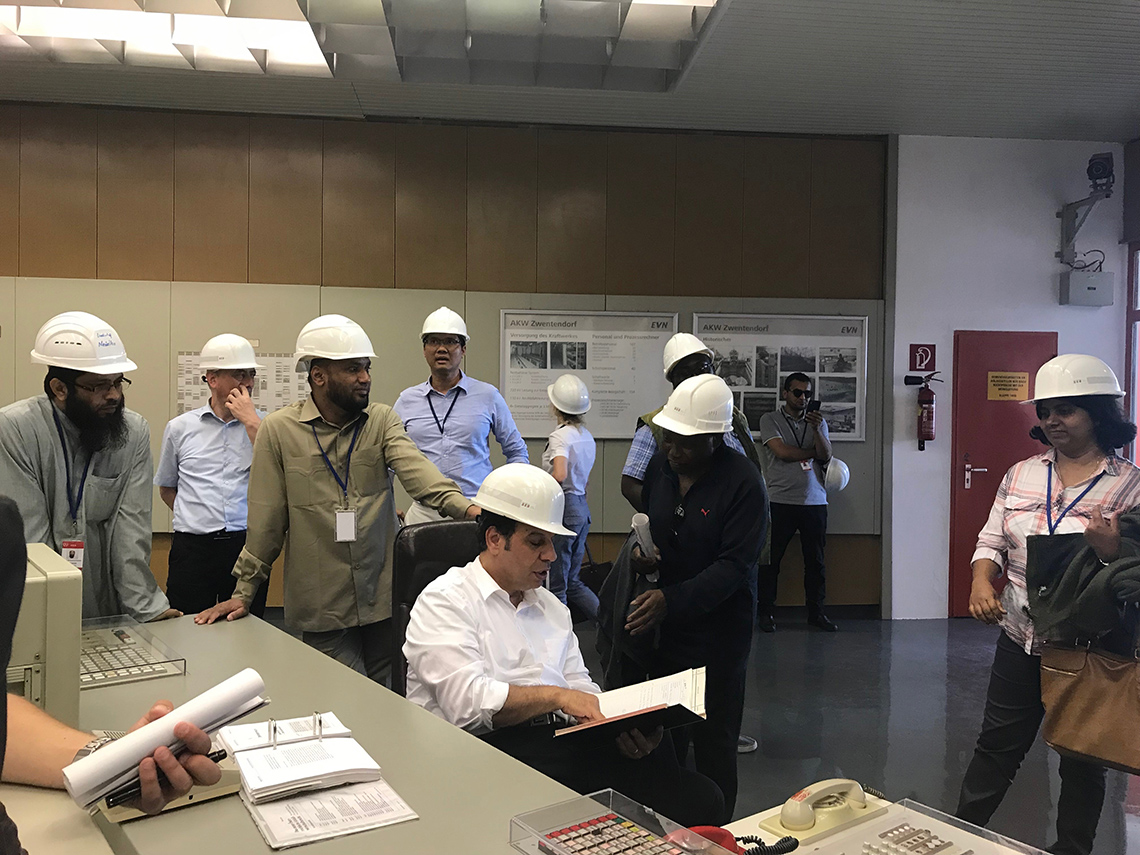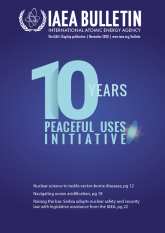
If you would like to learn more about the IAEA’s work, sign up for our weekly updates containing our most important news, multimedia and more.
Developing Nuclear Power Infrastructure in Newcomer Countries
Matthew Fisher

During a training course in July 2019, participants visited Zwentendorf nuclear power plant in Austria, which never went into operation and is used for training and demonstration purposes. (Photo: N. Kurova-Chernavina/IAEA)
While the construction of a nuclear power plant may be the most visible sign of a new nuclear power programme, major work behind the scenes is required beforehand. This includes building infrastructure in areas ranging from human resources to regulatory and legal frameworks. Thanks to significant funding through the Peaceful Uses Initiative (PUI), the IAEA can deliver a variety of programmes to help in the development of the infrastructure necessary for introducing nuclear power successfully.
Around 30 countries are currently considering or embarking on nuclear power and working with the IAEA to introduce this reliable, low carbon energy source in a safe, secure and sustainable way. The IAEA supports these nuclear newcomers with advice and capacity building under the Milestones Approach, a three-phase method that enables countries to develop a national infrastructure for a nuclear power programme.
The exercise helped us assess whether we have sufficient human resources to build and maintain nuclear power plants over the next several decades.
“Newcomers to nuclear have varying levels of infrastructural readiness, and our support programmes help countries with their unique situations on an as-needed basis,” said Milko Kovachev, Head of the IAEA’s Nuclear Infrastructure Development Section. “Funding from the PUI has allowed us to expand and tailor our assistance to several countries interested in developing nuclear power.”
Nuclear power programmes require a diverse mix of specialized, well-trained professionals in fields such as engineering, project management, nuclear safety and security and non-proliferation. To assist interested countries with planning and developing their human resources, the IAEA uses the Nuclear Power Human Resources (NPHR) modelling tool, which analyses human resource development plans for new nuclear power programmes.
Initially made available to the IAEA by the United States in 2011, the tool utilizes data encompassing all areas of a nuclear power programme and allows users to select various staffing approaches according to their country’s specific needs. The NPHR model is designed to help countries assess gaps in their human resources plans and project both the number and type of personnel that they will need for their nuclear power programme.
The IAEA provides free access to the tool, as well as conducts weeklong training courses on how to use it. To date, the IAEA has conducted NPHR training for more than 15 countries.
In April 2019, a training course on the NPHR tool was conducted in Vienna with experts from Niger, a country which is considering the introduction of nuclear power. The course provided an overview of how to use the tool and incorporated data specific to Niger, including elements of their educational system and existing workforce.
In October 2019, a workshop was held in Poland to provide feedback on the country’s national workforce plan and assist in updating its country specific NPHR model. Poland plans to deploy up to 9 000 GW(e) of nuclear power in the coming years in order to reduce its dependence on coal-fired power plants and cut carbon emissions.
“The greatest advantage provided by the training was the ability to simulate various scenarios with national baseline data according to dynamic changes in areas such as programme implementation schedule and availability of technical staff,” said Marzena Kurpinska, a specialist at the Polish Ministry of Climate and Environment’s Nuclear Energy Department. “The exercise helped us assess whether we have sufficient human resources to build and maintain nuclear power plants over the next several decades.”
Toward integrated management systems
To ensure the safety and effectiveness of nuclear power programmes, it is crucial to implement and maintain strong leadership and management systems. The four-year Integrated Management Systems (IMS) project, launched in 2017, aims to help newcomer countries understand the essential aspects of management and leadership, with an emphasis on coalescing elements of nuclear safety with security, safeguards, quality assurance and environmental protection into a unified, dynamic management system.
Project activities include expert missions and workshops designed to address specific gaps in management systems within both operating organizations and regulatory bodies. This is in line with the guidance laid out in Leadership and Management for Safety publication (IAEA Safety Standards Series No. GSR Part 2).
The IMS project also involves assessing countries’ management plans via document reviews conducted by either IAEA staff or external consultants and making suggestions for potential areas of improvement. Two such reviews were performed for Ghana in 2020. Ghana is advancing through the stages of nuclear power development, with Nuclear Power Ghana established in 2018 to manage the construction and operation of Ghana’s first nuclear power plant. Ghana’s Nuclear Regulatory Authority was established in 2015.
“The review missions were instrumental in helping us identify strengths and weaknesses as we move to an integrated management system for meeting safety and other requirements,” said Charles Kofi Klutse, a researcher at Ghana Atomic Energy Commission’s Nuclear Power Institute. “The review team helped us adopt a holistic approach to developing, implementing and continuously improving our management systems in line with the objectives of our nuclear power programme.”
Another tool developed with PUI funding is the Nuclear Infrastructure Competency Framework database. The database contains information on the competencies required for developing a nuclear power programme, based on the IAEA safety standards, nuclear security guidance and Nuclear Energy Series publications. Users may search the database for specific topics, such as infrastructure or implementation phase, to enhance their understanding of the competencies required at various stages of programme implementation.
Since its inception in 2010, the PUI has helped to raise more than €10 million to support infrastructure and human resource development projects. This includes interregional technical cooperation projects such as “Supporting Knowledgeable Decision-making and Building Capacities to Start and Implement Nuclear Power Programmes”, which is ongoing.





